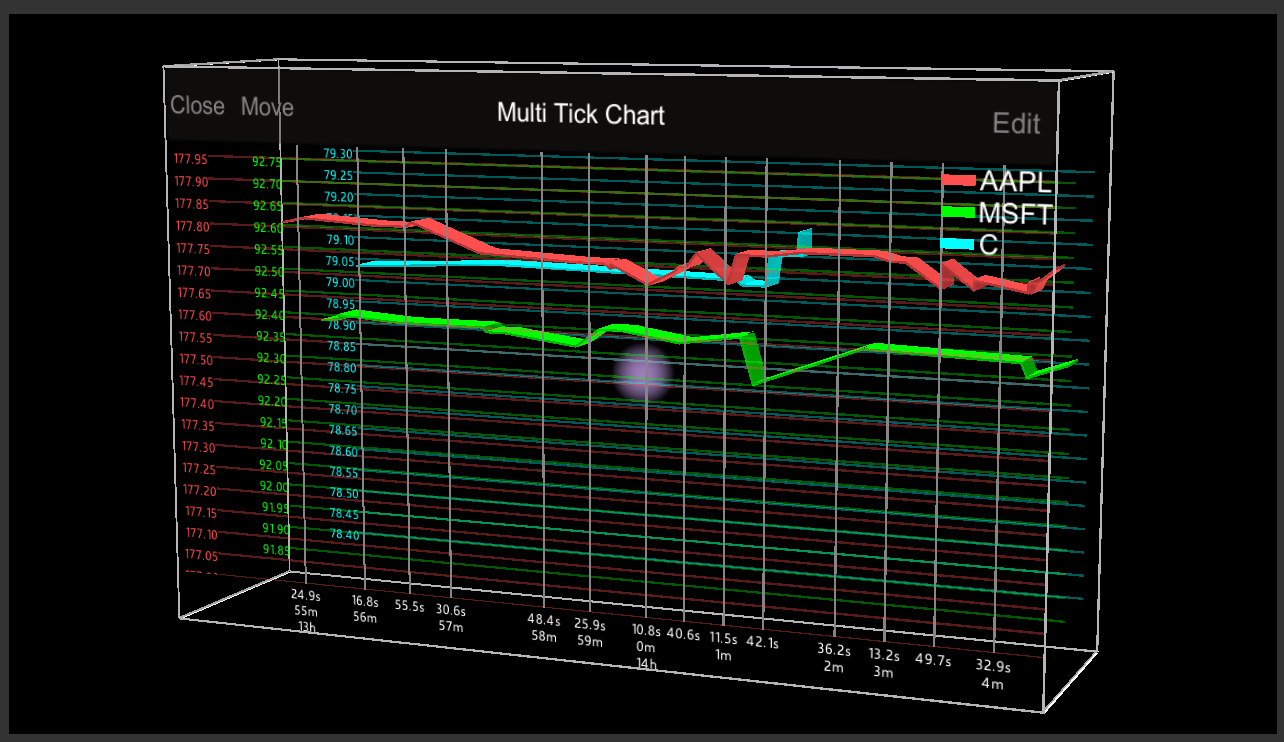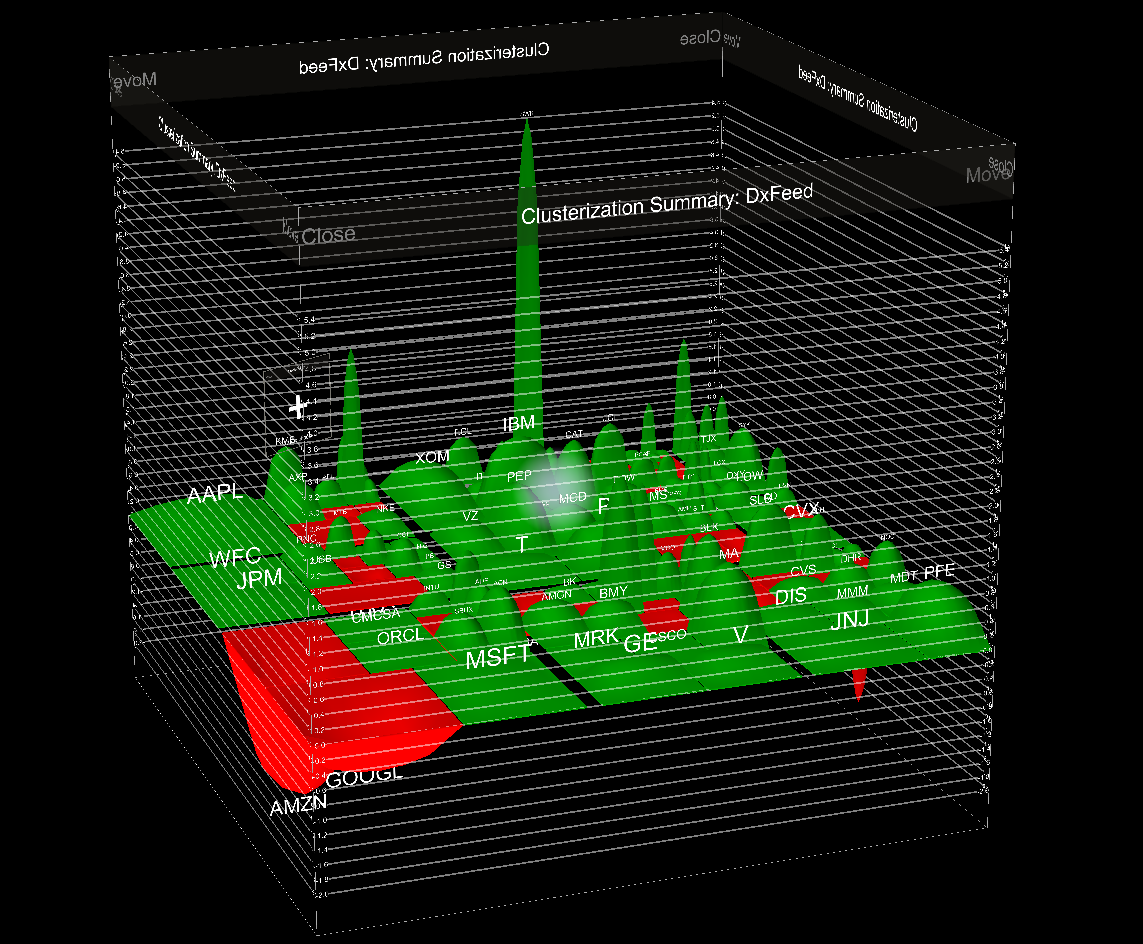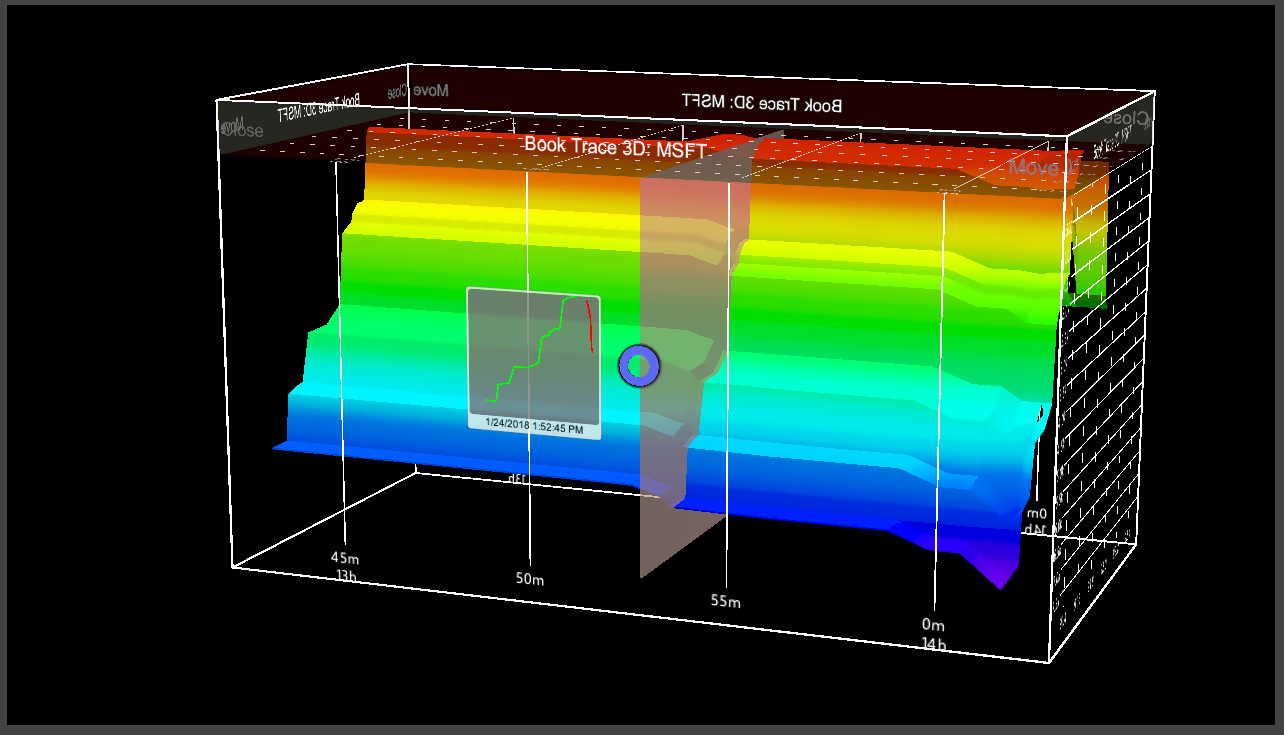Another reality of the financial market
“Our task was to research the opportunities and potential of HoloLens for players in the financial market,” the dxFeed guys told us. And we could not resist and want to tell you about it.

I give the word to the author.
')
dxFeed is a global data provider and developer of services for analyzing market data. In finance, market data is data on prices and trading in financial instruments reported by a trading platform (for example, an exchange). Market data allows traders and investors to find out the latest price and see historical trends for instruments such as stocks, fixed-income products, derivatives and currencies.
The end users of most of our analytical terminals are people who sit in front of several monitors all their working day and carefully study the charts of changing quotes, test various trading strategies on historical data, analyze the huge flow of market data and simultaneously monitor news channels before taking decision to buy or sell a financial asset.
To diversify its services and improve the quality of visualization of a huge amount of information, dxFeed developed an application for analyzing data based on HoloLens.
Financial markets and trading today are highly dependent on the degree of automation and algorithms. A person needs to analyze and process huge streams of information.
We moved financial and analytical platforms to Mixed Reality to give users (traders and investors) a chance to work with information at a deeper level.
Previously flat graphics became volumetric, the dimensions of the monitor ceased to matter, and a 360-degree view made it possible to open an unlimited number of screens.
According to our observations, private traders, investors and consultants in financial institutions all over the world show the greatest interest in these technologies: for them the possibility of cooperation without reference to location is extremely useful. Banks, investment funds, hedge funds, FX brokers and exchanges also master MR technologies in order to outrun their competitors and offer clients services, such as consulting in a virtual office or tracking their portfolio in 3D.
In early 2016, we began developing the dxFeed Holographic Solution financial application as soon as we received the first HoloLens Development Kit.
First of all, we visualized our own data, which we obtain from world stock exchanges, and for technical implementation, we were guided by Microsoft recommendations: use Unity , HoloLens gesture recognition technology, and voice recognition using Cortana.

This functionality, as well as the ability to manipulate holographic objects, can be extremely useful in many scenarios:
For an approximate understanding of the principle of the application and the list of technologies used, we consider a specific example. Suppose we want to display one of the most simple widgets — for example, a tick chart (Tick Chart). Such a graph shows the user time, prices and the volume of individual transactions, as well as a corridor of the best prices of supply and demand (Bid / Ask).
Data for the chart is provided as a Time and Sales event data stream, which dxFeed receives directly from the exchanges. For data processing we will use dxFeed C # API . Please note that this library is essentially a wrapper for the dxFeed C API , which, in turn, was designed for desktop Windows and uses WinSock2 to access the Internet instead of the Windows Runtime tools.
So, we connected the Time and Sales data stream to a specific specified character (for example, MSFT).

The widget itself will be nothing more than a

Naturally, this is only one of the variants of the course of events - sometimes the widget also needs to be updated after the user has clicked on the widget (Air Tap on HoloLens) or just looked (Gaze) on it. Sometimes the widget needs to change its size - for example, at the request of the same user. Some widgets have pop-up panels with a miniature image of the slice of the graphics in a given place. Or, sometimes you need to display a list of available symbols (financial instruments) so that the user can change the current one, or create a child widget that shows data in a different section.
In addition to widgets with graphs, tablets and other visualizations, the application can display news videos. The Unity engine itself cannot display a video stream, so I had to choose and use a specific third-party backend, in this case, the Microsoft Media Foundation. For him, they made their native plugin.
It should also be noted that now the possibility of sharing one work space with several points is being developed as a separate experiment. For this, transport from the Mixed Reality Toolkit and Vuforia-based computer vision software is used. At the widget level, this means that some part of its internal state (position, size, current displayed symbol) needs to be stored separately in one or another serializable data structure so that it can be exchanged with other devices.
Examples of other widgets that dxFeed Holographic Solution can now display:
The use of MR technologies in trading and data analysis has many advantages for financial institutions. For example, firms can replace a variety of monitors in their offices with compact wireless MR glasses, thereby removing the restrictions on users for screen sizes of computers, smartphones and tablets.
Companies can incorporate the workplace everywhere concept: with a 360 degree view, users can work on any surface and even in the air. Holographic technologies will enable users to improve their performance and improve the display of market data, which is a key element in timely financial decision making.
 Dmitry Parilov - Head of VR / AR dxFeed Company, Chairman of the FinTech Committee of the VR / AR Association (The VRARA). Dmitry began his career in the IT industry 12 years ago and now leads projects in the field of financial technology, leading teams distributed throughout the world.
Dmitry Parilov - Head of VR / AR dxFeed Company, Chairman of the FinTech Committee of the VR / AR Association (The VRARA). Dmitry began his career in the IT industry 12 years ago and now leads projects in the field of financial technology, leading teams distributed throughout the world.
Please note that now we are collecting applications for the international student competition Imagine Cup 2018 . The winner can win $ 100K.
On the eve of the competition, we are conducting a series of hackathons where you can find a team or mentor, talk with experts and present your project to them. The closest of them will be devoted to the development of MR / VR and will be held February 9 - 10 in Moscow with the support of AVRA and TemoCentre. Join now .

Disclaimer : this article is not intended to teach you how to develop for Holity on Unity. For this there is this article. Below you will find an excellent scenario of using mixed reality in the field of finance.
I give the word to the author.
')
dxFeed is a global data provider and developer of services for analyzing market data. In finance, market data is data on prices and trading in financial instruments reported by a trading platform (for example, an exchange). Market data allows traders and investors to find out the latest price and see historical trends for instruments such as stocks, fixed-income products, derivatives and currencies.
The end users of most of our analytical terminals are people who sit in front of several monitors all their working day and carefully study the charts of changing quotes, test various trading strategies on historical data, analyze the huge flow of market data and simultaneously monitor news channels before taking decision to buy or sell a financial asset.
To diversify its services and improve the quality of visualization of a huge amount of information, dxFeed developed an application for analyzing data based on HoloLens.
Mixed Reality in the financial industry
Financial markets and trading today are highly dependent on the degree of automation and algorithms. A person needs to analyze and process huge streams of information.
We moved financial and analytical platforms to Mixed Reality to give users (traders and investors) a chance to work with information at a deeper level.
Previously flat graphics became volumetric, the dimensions of the monitor ceased to matter, and a 360-degree view made it possible to open an unlimited number of screens.
According to our observations, private traders, investors and consultants in financial institutions all over the world show the greatest interest in these technologies: for them the possibility of cooperation without reference to location is extremely useful. Banks, investment funds, hedge funds, FX brokers and exchanges also master MR technologies in order to outrun their competitors and offer clients services, such as consulting in a virtual office or tracking their portfolio in 3D.
Let's talk about scripts
In early 2016, we began developing the dxFeed Holographic Solution financial application as soon as we received the first HoloLens Development Kit.
First of all, we visualized our own data, which we obtain from world stock exchanges, and for technical implementation, we were guided by Microsoft recommendations: use Unity , HoloLens gesture recognition technology, and voice recognition using Cortana.

This functionality, as well as the ability to manipulate holographic objects, can be extremely useful in many scenarios:
- A consultant may invite an investor in a virtual meeting room to show how a rise or fall in price affects a portfolio and demonstrate possible solutions.
- A financial analyst who tracks the stock of a particular company on the exchange can receive and visualize a huge amount of data, analyze past stock prices and instantly transfer the received information to his client in a holographic form.
- Students or new employees who are just learning to trade can use AR / MR technologies to study indicators and analyze patterns from historical data and reproduce market activity. It will also be an excellent opportunity for them to dive into financial markets for further interaction.
Implementation on one example
For an approximate understanding of the principle of the application and the list of technologies used, we consider a specific example. Suppose we want to display one of the most simple widgets — for example, a tick chart (Tick Chart). Such a graph shows the user time, prices and the volume of individual transactions, as well as a corridor of the best prices of supply and demand (Bid / Ask).
Data for the chart is provided as a Time and Sales event data stream, which dxFeed receives directly from the exchanges. For data processing we will use dxFeed C # API . Please note that this library is essentially a wrapper for the dxFeed C API , which, in turn, was designed for desktop Windows and uses WinSock2 to access the Internet instead of the Windows Runtime tools.
So, we connected the Time and Sales data stream to a specific specified character (for example, MSFT).

The widget itself will be nothing more than a
GameObject with a set of components. Processing of the received events on the side of the widget occurs in several stages:- Calculation of the current range of displayed data, labels on the axes, a set of displayed points, etc.
- Scaling and generation of geometry (triangles) by the displayed points. This operation includes a large amount of routine computational work, which makes it possible and consistent with its implementation through a compute shader (Compute Shader). That is, here it was necessary to write a shader, which scales the points, generates a solid line with a given thickness, cuts it along the border of the graph and adds thickness to it along the z axis for beauty. Note that this calculation can be performed not on each frame, but only once for updating the data.
- Generation of the rest of the geometry on the processor: the positions of the characters of the text, horizontal and vertical lines, the boundaries of the graph, etc. In the end it will all be merged into one Mesh.
- The final operations in the UI-stream: changing the
MaterialPropertyBlocks, taking into account the data at the output of the computational shader (that came toComputeBuffer) and any other changes; location of child Unity UI widget objects.

Naturally, this is only one of the variants of the course of events - sometimes the widget also needs to be updated after the user has clicked on the widget (Air Tap on HoloLens) or just looked (Gaze) on it. Sometimes the widget needs to change its size - for example, at the request of the same user. Some widgets have pop-up panels with a miniature image of the slice of the graphics in a given place. Or, sometimes you need to display a list of available symbols (financial instruments) so that the user can change the current one, or create a child widget that shows data in a different section.
In addition to widgets with graphs, tablets and other visualizations, the application can display news videos. The Unity engine itself cannot display a video stream, so I had to choose and use a specific third-party backend, in this case, the Microsoft Media Foundation. For him, they made their native plugin.
It should also be noted that now the possibility of sharing one work space with several points is being developed as a separate experiment. For this, transport from the Mixed Reality Toolkit and Vuforia-based computer vision software is used. At the widget level, this means that some part of its internal state (position, size, current displayed symbol) needs to be stored separately in one or another serializable data structure so that it can be exchanged with other devices.
Examples of other widgets that dxFeed Holographic Solution can now display:
- Market depth: classic stock glass in the form of a plate. One symbol from the list is displayed, which the user can change with a button on the widget.
- Watchlist: a table with various parameters for several financial instruments, for example, recent quotes, price and volume of the last transaction.
- Volatility Surface: dependence of an option’s own volatility on its strike and expiration.
- Clusterization Summary: the difference between the last trade price (last trade price) and the final price (summary price) for each symbol in the form of a histogram.

- Book Trace 3D: stock market state surface. Axis: time, price, cumulative demand / supply.

DxFeed Holographic Solution Perspective
The use of MR technologies in trading and data analysis has many advantages for financial institutions. For example, firms can replace a variety of monitors in their offices with compact wireless MR glasses, thereby removing the restrictions on users for screen sizes of computers, smartphones and tablets.
Companies can incorporate the workplace everywhere concept: with a 360 degree view, users can work on any surface and even in the air. Holographic technologies will enable users to improve their performance and improve the display of market data, which is a key element in timely financial decision making.
about the author
 Dmitry Parilov - Head of VR / AR dxFeed Company, Chairman of the FinTech Committee of the VR / AR Association (The VRARA). Dmitry began his career in the IT industry 12 years ago and now leads projects in the field of financial technology, leading teams distributed throughout the world.
Dmitry Parilov - Head of VR / AR dxFeed Company, Chairman of the FinTech Committee of the VR / AR Association (The VRARA). Dmitry began his career in the IT industry 12 years ago and now leads projects in the field of financial technology, leading teams distributed throughout the world.Mixed Reality Imagine Hack
Please note that now we are collecting applications for the international student competition Imagine Cup 2018 . The winner can win $ 100K.
On the eve of the competition, we are conducting a series of hackathons where you can find a team or mentor, talk with experts and present your project to them. The closest of them will be devoted to the development of MR / VR and will be held February 9 - 10 in Moscow with the support of AVRA and TemoCentre. Join now .
Source: https://habr.com/ru/post/348270/
All Articles